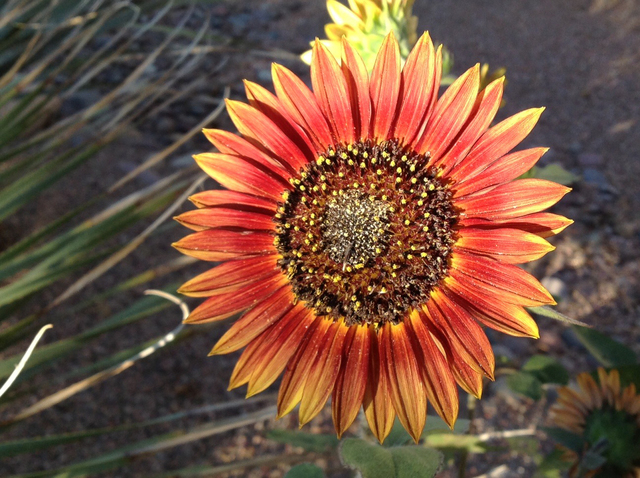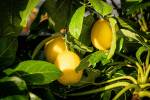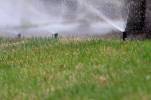Let It Grow
Southern Nevada isn’t known as an ideal growing environment for a papaya or mango. But don’t tell Brian Wignall that. The 25-year valley resident has found ways to grow the seemingly impossible in the harsh Mojave sun, and he says anyone else can do it too. And Wignall’s northwest valley home is a testament to his thinking.
“Basically what we’ve done is challenge all the nurseries who say ‘you can’t grow that here,’ ” Wignall said. “People are really missing out on what you can do in Las Vegas or the Southwest. … Once you try exotics then it really gets fun. You realize you can do anything.”
Southwest enthusiast
Wignall’s desire to better understand growing fruits, vegetables and plants in the desert stems from the Iowan’s longtime interest in culture and history west of the Mississippi. He’s had his curiosity on display for all to see in several television shows.
Wignall, now 53, first approached Vegas PBS about doing an outdoor show more than 20 years ago. His efforts have included roles with “Outdoor Nevada,” “Southwest Adventures” and “Waters of the West,” informational programs that focus on stories, people and places unique to the Silver State and the Western United States. He won an Emmy Award for Outstanding Achievement in 1998 for his work with “Outdoor Nevada.”
His most recent effort, “Southwest Living,” which airs Wednesdays at 7:30 p.m. on Vegas PBS, Channel 10, delves into the cultures, cuisines, traditions, lifestyle, art and histories of the Southwest. On any given week, Wignall, along with his wife, Julie, and daughter, Amelia, shed light on places and faces unique to the Desert Southwest.
“You just keep going down the rabbit hole and it gets quite interesting,” he said.
Gardening is a focus for the show, which started airing in January, and Wignall’s insights are great for a newbie or seasoned gardener trying to grow anything in the valley heat. His knowledge is the product of years of trial and error, he admits.
Soil fix
The Wignall home, located near Rainbow Boulevard and Sahara Avenue, is built on a half-acre parcel. When he purchased the home 20 years ago, the goal was to have enough space to experiment with planting and gardening.
Today, the Wignall house is home to eight varieties of grapes, 24 different types of roses, pecans, papayas, plums, nectarines, watermelons, lemons and oranges —and that’s really only scratching the surface.
The key to growing anything in the Mojave Desert lies in a unique soil mixture Wignall created himself through the years. The Southwest enthusiast explains how the Las Vegas Valley was once an inland sea, which has left the soil extremely salty. The ground compacts too easily, making it difficult to grow much of anything. But with the right amendments, that can change.
Wignall’s mixture involves two parts basic potting soil; one part peat moss to help with water retention; one part perlite, which is actually a volcanic glass material that facilitates moisture to plant roots; sand, for drainage; and soil sulfur, a slow-release fertilizer that insects hate.
“Plants, like roses, need to have the soil completely changed out,” Wignall said. “This potting mixture allows us to do a lot of things. … We can grow pistachios from the Middle East, pecans, pineapples … mangos and papayas.”
Micro-zones
While fixing the soil is key, Wignall also emphasizes the importance of a plant’s location in his yard. He has his yard divided into what he calls “micro-zones,” a name he coined after years of studying plants that did well and others that did poorly in shaded and sunny areas of his yard.
“About 20 years ago, I started noticing how things grew differently between my front and backyard,” he noted. “I had a shady spot facing north. One plant worked and another didn’t. Another plant baked on a west-facing wall and my bougainvillea was doing just fine.”
Tropical fruits like mangos and pineapples and citrus do indeed thrive in the hot sun, he added. So planting them in areas of heavy shade can be a problem. Once the soil is improved, the tropical plants can actually do quite well.
The front of his house, which receives considerable sun, is all desert plants. His backyard has a swatch of low-water grass around the perimeter, and many 6-foot-by-6-foot growing areas. Some plants or fruits are even planted in pots. But all are placed in a place where Wignall has given careful thought to sun exposure, or the lack of it.
“You really have to know these micro-zones in your yard,” he added. “That is the key.”
Starting out
If you’re wanting to learn more about micro-zones in your own yard, Wignall recommends digging a hole where you’d like to plant something and monitoring the amount of light its gets throughout the day. Nursery employees can be more helpful about suggesting plants when they have a clear understanding of how much sun exposure a space is getting, Wignall explained.
Only use a soap-based insecticide, he added. A homemade one can be made by simply using Dawn dishwashing detergent. Pepper sprays also work well as an insecticide.
Wignall only recommends water-soluble fertilizers. Some gardeners are encouraged to use pelleted nitrogen, but the gardening pro cautions that too much nitrogen can actually burn a plant.
Seeds, rotation
Wignall has used mango seeds, papaya seeds, cutoffs from a green onion and numerous other parts and seeds from plants to grow his own at home.
“For us, there’s very little waste in the things we get from the grocery store,” he added. “The seeds from a chili pepper are viable for up to a year. … There’s really no need to go out and buy any seeds.”
Wignall also likes to move plants around his yard, paying close attention to which zones work for them, not unlike how corn and squash was rotated by the Native Americans and today’s framers rotate beans and corn. Moving plants is good for the plants and crops as well as the soil.
“Like real estate, it’s placement, placement, placement,” he said. “Do not be afraid to move plants. Shrubs, bushes, small trees, no problem. It’s also an opportunity to amend the soil.”
In the future, Wignall would like to see his show expand and offer more access to online and products that can help people learn about the Southwest and gardening.
“We’re kind of on a mission to educate and empower people to grow things and appreciate the culture and lineage of the Southwest,” he added.
For more information about the show and future episodes, visit southwestliving.tv.





























